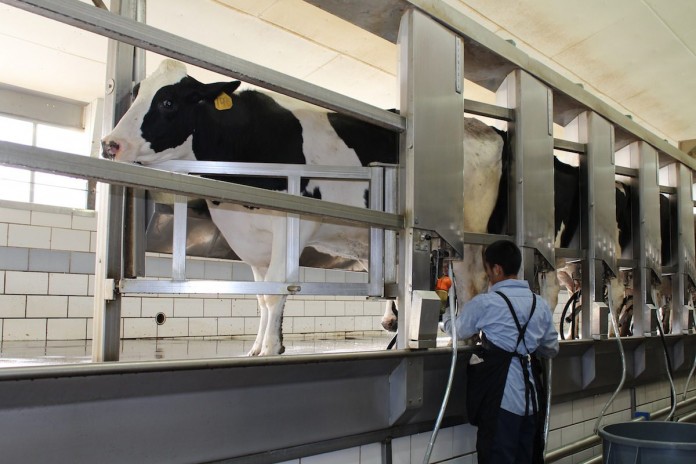SUGARCREEK, Ohio — Dairy farmers got an update on some of the biggest issues facing their industry during the second of two fall meetings Nov. 7 in Sugarcreek.
The meeting was held at Dutch Valley Restaurant, followed by a tour of the 1,200-cow Andreas Farms.
Most of the event focused on water quality — an always-important topic to dairy farmers, but especially as the state ramps up its efforts to combat algal blooms in Lake Erie and elsewhere.
Scott Higgins, CEO of Ohio Dairy Producers Association and American Dairy Association Mideast, talked about the significance of the toxic blue-green algae that are blooming as a result of nutrient runoff.
By the source
The nutrients are coming from municipalities, lawn care chemicals and agriculture. In the most severe algal blooms, the water cannot safely be entered or consumed, and it can make pets and humans become ill.
“Agriculture is not afraid to take responsibility for what portion of it we are responsible for,” Higgins said. “But we also know there’s other players involved, too.
”The state formed an ag nutrients work group in 2011 to address what agriculture could do. It was organized by the directors of the Ohio Department of Agriculture, Department of Natural Resources and Environmental Protection Agency.
Higgins said ODPA was actively involved in those meetings, alongside 100 other entities that included farmers, and other trade representatives.
New legislation
The meetings resulted in new legislation that was crafted this spring and introduced in the Ohio Senate June 25, that would set new standards for how ag nutrients are regulated in Ohio.
The bill, as it stands, would generally require fertilizer applicators to be certified, and adds new definitions to what is considered a pollutant, including nutrients added to the soil.
Higgins said ODPA took issue with some of the initial language of the bill, at multiple points in the process, but he said the bill is becoming more acceptable.
“The language in the bill today is far better than before,” he said.
Voluntary effort
A big concern of ODPA, he said, is that dairy farmers want to have the chance to take action voluntarily.
“We don’t want someone to tell us exactly how we’re going to do it and exactly the amounts of fertilizer we can apply,” he said. “But we’re willing, as an industry, to demonstrate to consumers that we’ll do the right thing.”
Under the ODPA plan, the state would still set the criteria and framework for voluntary efforts, but it would be up to farmers to follow that framework.
Keep records
A big thing, Higgins said, is that farmers need to be keeping records. They could provide “an affirmative defense” in the future, if farmers are challenged for what they applied.
Mark Scarpitti, state agronomist with the Natural Resources Conservation Service, demonstrated how different soils — ranging from no-till to conventional tillage — fare during rain events.
Using different soil samples, he poured water over the top, showing how no-till soil holds up much better and does a better job of allowing the water and nutrients to infiltrate.
The reason, he said, is the no-till soil has a much better soil structure, including worm channels and organic matter. Although no-till may take a few years to establish, it’s usually the better choice for conservation.
When soil is tilled, organic matter “oxidizes away” and the material that binds the soil structure together is lost. When that happens, it only takes “a little bit of rainfall” for the soil particles to disintegrate.
Reduce compaction
Scarpitti also encouraged farmers to reduce passes across their fields, and consider equipment that makes uses of controlled traffic patterns — where the same wheel pattern is used as much as possible — minimizing the total area of the field that is run over.
“You wouldn’t drive over your garden and then try to grow vegetable crops on it, but we do all that all the time with our row crops,” he said.
Compared to grain farmers, he said dairy farmers have some extra challenges, but they also have some additional opportunities. For instance, livestock manure.
As long as it’s applied responsibly, dairy farmers are “basically inoculating (their) soil with microorganisms, which is a good thing,” he said.
Those microorganisms help create a healthier soil for crops, and improve the root structure.
Other topics
The meeting also included an update on the federal Animal Disease Traceability Rule, which became effective in March.
The rule applies to producers who haul livestock across state lines, and basically requires that those animals be officially identified and that the shipper have the appropriate moving documents. All rules are subject to the receiving state, so producers should check with the receiving state for any exceptions.
Farm and Dairy printed an article about the new rule in the Nov. 7 edition.
Farm tours
At the conclusion of the meeting, a tour was held at Andreas Farms, operated by Dan and Matt Andreas and their families.
A popular feature was a new manure separator. The system separates the liquids from the solid portion of manure, and can handle up to 2,500 cows per day.
The solids are sold to Bull Country Compost, of Dundee, Ohio, and the liquids are applied to the fields via a dragline system.
Logan County
The farm tour following the Nov. 6 dairy meeting was in Logan County, at Alan and Renee Winners’ farm. They milk 190 Holstein cows on four Lely A-4 robotic milkers and use an automatic calf feeder, Juno feed pusher, and brushes in their newly remodeled flush barn.










